【Learning points】
- Patients after stroke may be unable to turn over on their own due to weakness in their limbs. If the patient can correctly position his limbs when lying in bed, he can avoid spasms, limb pain, and prevent joint deformation or dislocation.
- Assistance is required to turn over at least once every 2 hours. When the patient is lying on his side, a pillow can be placed on the patient's back and sandwiched between the legs to provide pressure relief and support.
- When a patient with unilateral weakness gets out of bed and walks, the caregiver should stand on the affected side of the patient, wrap his hands from behind to the waist, and hold the belt or trousers.
I.What is rehabilitation?
Rehabilitation exercise is the use of various therapeutic exercises and training to help patients maximize their physical fitness; early rehabilitation assessment and treatment can be used to return to normal life functions.
II.The goal of rehabilitation.
Use a variety of activities to improve the patient's muscle strength, cardiorespiratory tolerance, joint range of motion and the maintenance of correct posture, promote the flexibility and coordination of hand and foot movements, and train patients to use wheelchairs, walkers and other aids to train and use food , dressing, bathing, toileting, moving and other daily life function training, improve the patient's ability and independence of daily self-care.
III. Type of rehabilitation.
- Passive movement: Patient cannot move by himself. Patients need to be completely assisted by others.
- Active-assisted exercise: patients are able to perform limited exercise; the rest should be assisted by others.
- Active exercise: Patient is able to complete intact movement.
- Motion-resistance force: Patient’s muscle resist against to the assistant or special equipment. To induce neuromuscular reaction of the patient.
IV.Precautions when performing passive exercise
- To prevent stiffness and deformation of the limbs and joints, the paralyzed or functionally impaired limbs should be moved as early as possible.
- Start with passive movement and gradually turn to active movement.
- Before exercising, apply warm water bath or body heat to relax joints and muscles, which is beneficial to exercise.
- When starting passive exercise, the force and range of motion should not be too large to avoid damage to the joints.
- Fix the proximal joint (the joint near the heart) and support the distal joint (the joint far from the heart), move the joint with slow and gentle movements, and reduce the range of motion if pain occurs.
- If there is muscle spasm or resistance, the joint movement should be carried out slowly and operated with gentle and stable force until the muscles relax.
- The most important thing in carrying out exercise is: the patient must have full confidence in himself, and family members or helpers should have infinite patience and love, give the patient the greatest support and encouragement, and make the patient willing to cooperate automatically. Only then can exercise be truly function.
V. Basic joint activities (Figure 1)
- Abduction: The limb is moved away from the midline of the body.
- Adduction : The limb moves towards the midline of the body.
- Flexion: Bend the joint to reduce the angle.
- Extention: The joint is returned to extension from flexion.
- Medial Rotation: the movement of turning the sole of the foot to the inside.
- Lateral Rotation: The movement of turning the sole of the foot to the outside.
- Rotation: to rotate or move around an axis.
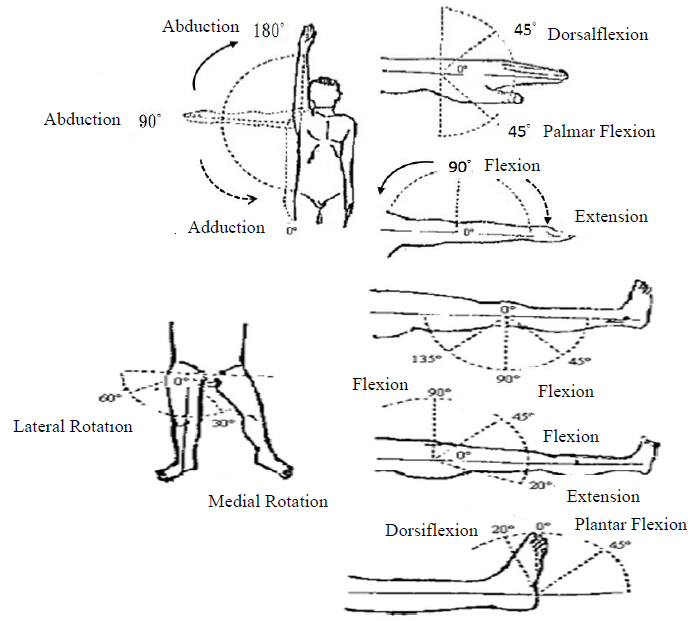
Figure 1 Movable area of limb joints
VI.Rehabilitation treatment for stroke:
The sequelae and complications of stroke are quite numerous. Rehabilitation treatment will be carried out according to the symptoms and severity of individual patients, including:
- Physical therapy: movement difficulties, abnormal gait or balance disorders, reconstruction of motor function (muscular endurance, balance, coordination) and walking ability.
- Occupational therapy: daily life training, such as: self-care such as eating, hygiene, putting on and taking off clothes, splint, scaffolding, assistive device evaluation and training.
- Speech therapy: Correcting speech disorders, such as patients with aphasia, using communication aids, giving training inoral language and understanding and expression; and treating swallowing dysfunction.
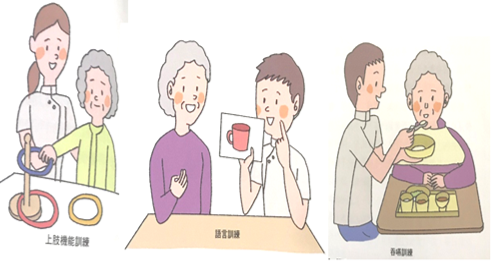
VII. Upper and lower limb joints perform movements (Figure 2 and Figure 3)
The number of executions:Three times a day.(Morning, noon, night). Each movement repeat 10-15 times. Base on patient’s condition, use passive exercise, active-assisted exercise or active exercise.

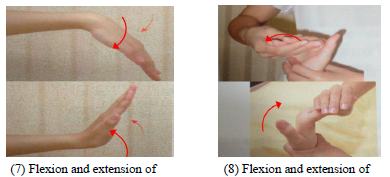


Figure 2 Upper limb joint movement
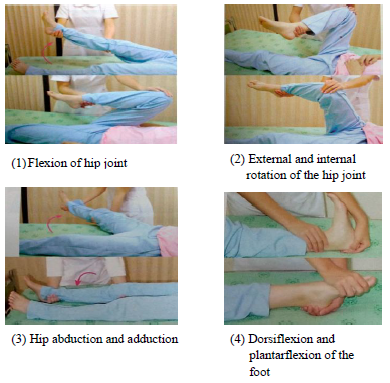
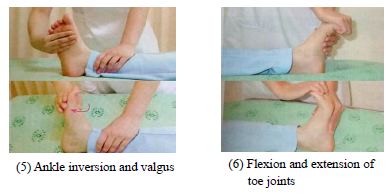
Figure 3 Lower extremtity joint movement
VIII. Conclusion
Early intervention in rehabilitation exercise can not only reduce the degree of disability, prevent comorbidities, and promote the recovery of physical activity, but also help patients return to work, rebuild self-confidence in life, and return to society.
IX. References
- Taichung Veterans General Hospital (October 31, 2018). Rehabilitation treatment of stroke. Retrieved from https://www.vghtc.gov.tw/GipOpenWeb/wSite/ctxItem=46353&ctNode=46086&mp=3032&idPath=14147_46049_46086
- Weng, S.M., Lin, R.C., Lin, C.F., & Lin, C.(2018). A nursing project on the improvement of muscle strength of acute stroke patients. Yuanyuan Nursing, 12(1), 36-45. https//doi.org/10.6530/YYN/2018.3.1
- Huang, Y. C., & Ku, H. C.(2021).Nursing experience of caring for an acute stroke patient with rehabilitation therapy. Kaohsiung Nursing Journal, 38(3), 87-99. https//doi.org/ 10.6692/KJN.202112_38(3).0008
- Li, S.L., (2021). Activity and physical training demand. In Su, Li-Jhih (Eds.) Practical basic nursing (Volume 1) (8nd ed., pp. 361-416). Hua Xing Publishers.
Simple test
Let's take a test to confirm that you have a thorough understanding.
評語
統計結果不開放
請登入後才可以評分
未登入或權限不足!
- 位置
-
- 資料夾名稱
- English
- 上傳者
- 楊欣宜
- 單位
- 中榮護理衛教
- 英文名稱
- Stroke Rehabilitation Exercise
- 分類
- 治療
- 科別
- 英語
- 癌症照護
- 否
- 建立
- 2024-01-25 03:56:39
- 最近修訂
- 2024-08-30 20:37:24
- 版本
- 2024-08-30